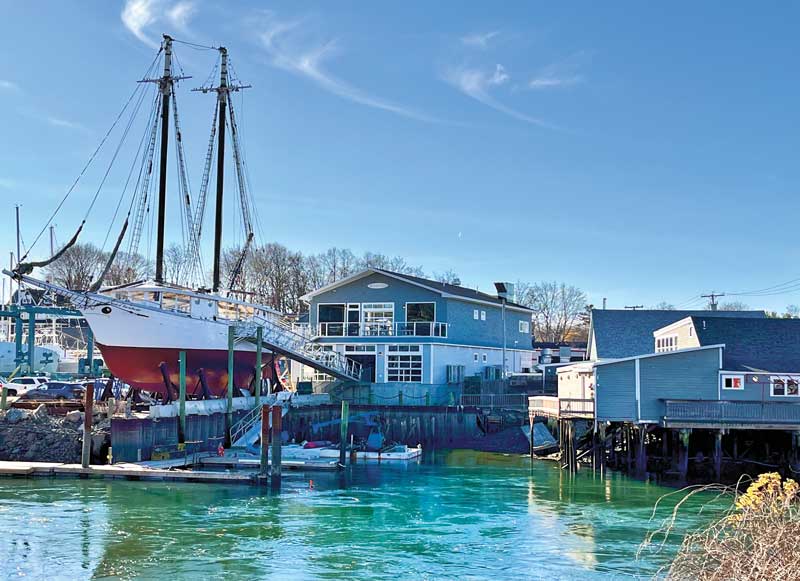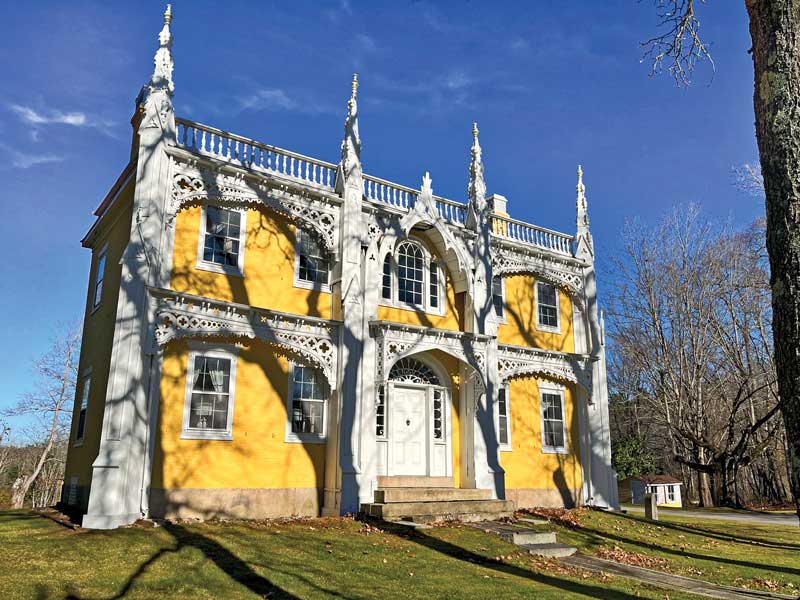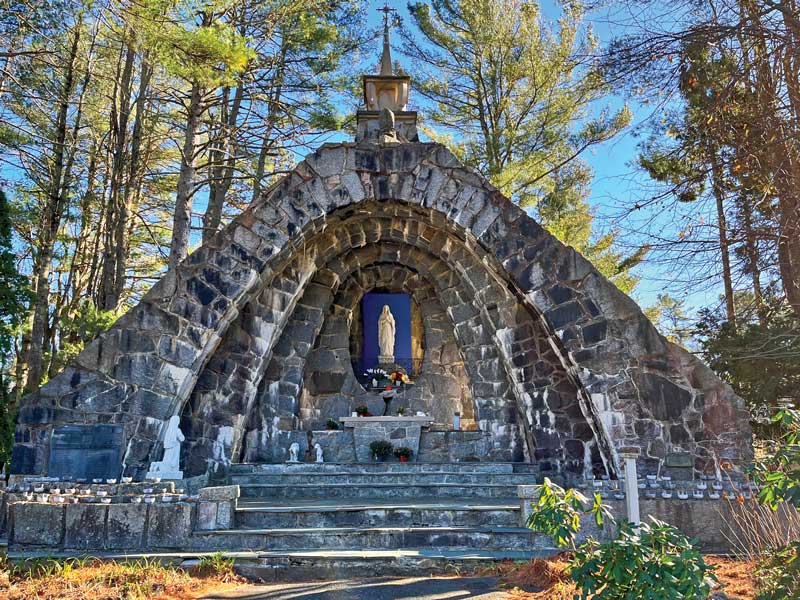All photos by Mimi Bigelow Steadman
 The Spirit of Massachusetts serves as a reminder of the 19th-century, Kennebunk-built ships that tied up here before sailing away.
The Spirit of Massachusetts serves as a reminder of the 19th-century, Kennebunk-built ships that tied up here before sailing away.
When we spied two traditionally rigged wooden masts rising over rooftops near the bridge from Kennebunk to Kennebunkport, it felt as though we’d been whisked into the past. We’d just learned that in the 1800s, this location on the Kennebunk River was the embarkation point for locally built ships setting sail for distant lands. The 125-foot-long schooner Spirit of Massachusetts, which sits on the hard beside the Pilot House Restaurant where it’s used for warm-weather dining, seemed to mirror history.
We’d come from the Brick Store Museum, where volunteer Donna Griglock had told us that during 19th-century winters, as many as 20 boatyards stayed busy constructing vessels alongside the Kennebunk River. They’d launch the ships after the ice melted and float them down to this spot near the river’s mouth.
Local shipbuilding began on the Mousam River in the 1700s. It later moved to the Kennebunk River where it continued into the early 1900s. “That’s when demand shifted to larger, powered vessels that were too big to fit down the narrow, winding waterway,” Griglock said. She explained that mills soon took over as the town’s premier industry, producing such products as textiles, paper, and flour.
On our way down Summer Street toward Lower Village and the river, we’d passed a lineup of beautifully maintained 19th-century mansions. They are impressive testimony to the wealth amassed by shipbuilders, ship owners, sea captains, mill owners, and merchants a couple of centuries ago. Among the largest is a Georgian-style house known today as the William Lord Mansion, built around 1760 and purchased in 1822 by Lord, a successful shipbuilder who saw more than 40 ships go down the ways at his yard. He also had the Brick Store built from locally kilned bricks in 1825. The building is currently part of the Brick Store Museum.
 Kennebunk’s most recognizable mansion is appropriately called the Wedding Cake House.
Kennebunk’s most recognizable mansion is appropriately called the Wedding Cake House.
No doubt the most-recognized mansion is the yellow Wedding Cake House, constructed in 1825 by George Washington Bourne, whose shipyard, Bourne & Kingsbury, stood on the nearby riverbank. On his travels, Bourne had been taken with the Duomo in Milan. Inspired, he and a crew of local shipwrights began “icing the cake” with carpenter-gothic trim in 1852. It is currently for sale for around $2.5 million.
At Lower Village, we headed south onto Beach Avenue. A half mile later, we turned in at the Saint Anthony Franciscan Friary, which welcomes visitors. Purchased by Lithuanian Franciscans from a wealthy entrepreneur in 1947, the estate features a century-old Tudor-style mansion-turned-monastery. As we walked around a central parklike expanse originally designed by the Olmsted Brothers, we came to a small grotto dedicated to Our Lady of Lourdes. On the altar, I found an open journal in which visitors had written moving prayers of supplication and gratitude.
 The Grotto of Our Lady of Lourdes is sequestered on the Saint Anthony Franciscan Friary grounds.
The Grotto of Our Lady of Lourdes is sequestered on the Saint Anthony Franciscan Friary grounds.
Beyond the friary, Beach Avenue leads to the shore, which is scalloped by a succession of broad beaches. Taking advantage of the ease of offseason parking, we pulled over to watch runners, walkers, and dogs enjoying strolls in the autumn sunshine. At least a dozen wetsuit-clad surfers bobbed on the water, waiting for their next wave. To me, they looked just like a flock of oversized seabirds.
Commanding a point between Goochs and Middle beaches, the grand, gambrel-roofed Narragansett by the Sea is one of just a few remaining summer hotels built during the early 20th century when citified guests traveled by train and trolley to enjoy leisurely stays on the Maine coast. Opened in 1905, it boasted 60 guestrooms—and one bathroom. Now converted to condos, its amenities have no doubt greatly improved.
Back in the center of town, we took a walk along Main Street to read a series of Museum in the Streets signs, each one offering a nugget of history. From the one in front of the beautiful First Parish Unitarian Church, we learned that it was built in 1773. After its bell tower was added in 1803, it was hung with a 1,017-pound bell cast by Revere and Sons. Originally costing $452, it’s one of only 23 surviving Revere bells.
The history of the belfry reminded me of an article I’d recently read on seacoastonline.com that revealed that notes left by the tower’s architect mentioned “Negro seats” in the tower. They were apparently positioned so the occupants could see the church service below while being removed from it.
It deepened the poignancy of something I’d seen that morning at the Brick Store Museum: empty frames hung among antique portraits of the wealthy and successful. According to a sign next to them, they honor local residents whose position in society meant they never had their portraits done. A short list of names of formerly enslaved people and Wabanaki who once lived in Kennebunk is inscribed on the wall.
Amid the history of Kennebunk’s grand ships, elegant mansions, and refined resorts, it’s heartening that people who are so often forgotten are remembered here, too. As we walked back down the street, the Revere bell tolled the hour.
✮
Contributing editor Mimi Bigelow Steadman lives on the Damariscotta River in Edgecomb when not exploring new destinations.
If You Go to Kennebunk
On the Water
The town of Kennebunk maintains two transient moorings in the Kennebunk River for boats up to 30 feet long with a maximum 5-foot draft ($25 per night; maximum of three nights). To reserve and pay, call the harbormaster at 207-205-0991. For larger boats, safe anchorage in about 20 feet of water can be found just outside the river, within the following sets of coordinates: 43° 20.56' N, 70° 28.84' W and 43° 20.38' N, 70° 28.88' W. The dock at DiMillo’s Marina Kennebunk can accommodate boats up to 85 feet long; sometimes there’s space for larger vessels, too. There is plenty of water at low tide. Charged according to length, nightly rates range from $5.50 to $7 per foot. Three-hour dockage, when available, is $1 per foot. First Chance Whale Watch trips and lobster cruises depart from here, and New England Eco Adventures’ sightseeing and whale-watch cruises are based nearby.
Eat
For a sandwich, quiche, or light breakfast or lunch, stop at Boulangerie, where a variety of breads comes fresh from the oven. The menu includes pastries, muffins, biscuits, and scones. Beside the bridge to Kennebunkport, the seasonal Clam Shack dishes up takeout fried clams, fish, and French fries. Despite its name, it’s probably best known for its lobster rolls. Federal Jack’s, named for a Kennebunk-built schooner of yore, is located nearby at DiMillo’s Marina. The birthplace of Shipyard Brewing Company, its menu is heavy on fresh seafood, along with some favorite landlubber dishes. Also nearby is The Pilot House, where the schooner Spirit of Massachusetts serves as a bonus bar and dining area in summer. Its menu also features seafood favorites and other comfort dishes, served amid nautical décor and water views. In the Lafayette Center—a repurposed redbrick mill building in downtown Kennebunk—Duffy’s Tavern is a cozy, welcoming eatery serving good pub fare. Recipient of numerous accolades, the White Barn Inn welcomes guests to dine elegantly in a refined, rustic setting or enjoy a lighter meal in the more casual, moderately priced Little Barn.
Shop
Kennebunk is home to numerous antiques, home-décor, and gift shops, many of which can be found either along Route 1 or in the Lower Village. Check out Americana Workshop for antiques, custom furniture, and estate jewelry; Sue Rioux Designs for glass kaleidoscopes; Seacraft for a mix of antiques and new treasures; and Maine Art Hill for a well-curated selection of paintings, fine-art prints, sculptures, and photography. At Old House Parts Company, you’ll find a trove of antique windows, doors, hardware, and other reclaimed architectural details. Centered on a lovely, early-1800s house just south of town, Wallingford Farm’s store sells Maine-made condiments, Maine Shaker products, and Pennsylvania Amish preserved foods. There’s a greenhouse, too, with abundant flowering plants available in the warmer months.
Do
Housed in the original 1825 Brick Store and three neighboring historic structures that have been connected, the Brick Store Museum mounts enlightening exhibits on the history, cultures, and art of the Kennebunk area. The general store was built from locally kilned bricks by shipbuilder William Lord. His granddaughter, Edith Barry, opened it as a museum in 1936. Items from the Lord family comprise the nucleus of the museum’s collection. Open daily, year-round, the museum features rotating, specially themed exhibitions. To learn the town’s history while on a sightseeing stroll, keep a lookout for Museum in the Streets signs. Kennebunk is blessed with a string of beautiful sandy beaches that are open to the public. Parking can be challenging at the season’s height.
Hike and Paddle
Visitors are welcome to stroll the peaceful grounds and visit the chapel at Saint Anthony Franciscan Friary from sunrise to sunset. Paved, wheelchair-accessible trails wind through gardens and along the edge of the Kennebunk River. The Kennebunk Land Trust stewards more than a dozen preserves that offer upland forest, coastal marsh, and agricultural fields. Among them are the Alewive Woods Preserve, whose 625 acres include a 45-acre pond and trails that lead through a red-pine plantation; Clark Preserve, which offers more than 2,000 feet of frontage on the Kennebunk River; and The Secret Garden, whose 1.5-mile trail leads to extensive fern beds deep in the forest. Managed by The Nature Conservancy, the 2,000-acre Kennebunk Plains Preserve’s grasslands are a primo birding area. The world’s largest population of the endangered northern blazing star, which produces a stunning array of purple blooms in late summer, can also be enjoyed here. Kayak Excursions in Kennebunkport offers half-day and longer kayak and paddleboard rentals with delivery to you.






